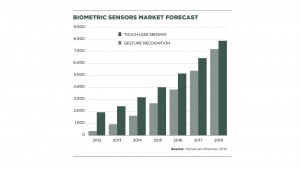 It’s hard to think of biometric identity technology without picturing Tom Cruise on the run in the movie Minority Report. Hunted by killer robots with iris scanning equipment and hailed by animated billboards that use similar tech to personalise their adverts, Cruise is reduced to a full eye transplant to evade capture and death.
It’s hard to think of biometric identity technology without picturing Tom Cruise on the run in the movie Minority Report. Hunted by killer robots with iris scanning equipment and hailed by animated billboards that use similar tech to personalise their adverts, Cruise is reduced to a full eye transplant to evade capture and death.
It made for a great film, but it didn’t do the biometrics industry many favours. Active in one form or another since the invention of fingerprints, the commercial use of biometric data has proceeded in fits and starts over the past 20 years. One possible delay to what was assumed to be inevitable when the movie was released in 2002 is viewers’ nervousness about technology that looked creepy and invasive.
“People in the UK have proved wary of eye-scanning systems to date,” says Steven Murdoch, principle research fellow in the department of computer science at University College London.
Iris-scanning systems designed to speed up immigration at major airports were scrapped in 2012 after an investment of £4.9 million. Introduced in 2004, the electronic gates and iris scanners were hailed as a ‘watertight’ system for cutting fraud and waiting times. The technology, however, was unreliable and passengers were forced to wait far longer than if they’d simply queued for an immigration officer.
“It may be prompted in part by sci-fi films or may even run a little deeper,” Dr Murdoch says. “In Japan, for instance, ATMs use palm scanning technology, which read the unique pattern of veins in the palm of each customer. That’s great in a culture that’s very concerned about hygiene and would prefer not to touch a machine that other people have used all day long.”
Biometrics have become about convenience rather than just security, which is speeding up acceptance
While iris-scanning is currently on hold almost everywhere apart from the Mexican city of Leon, which installed scanners for everything from cash machines to paying bus fares back in 2010, other biometric measures are already with us.
Indeed, a recent study by TechSci Research forecast annual growth rates of 14 per cent in the biometrics market, which should reach $21 billion (£13.5 billion) by 2020. “The demand for biometric systems is increasing at a much higher rate in countries such as China, India, Japan and Indonesia when compared with the United States and Canada, due to increasing focus on identity management and curbing security breaches,” says TechSci analyst Kalpana Verma. What’s changed”
“The greatest advance in biometrics is the iPhone 6,” argues Ramesh Kesanupalli, who heads up the FIDO Alliance, an industry-wide lobbying group hoping to establish Bluetooth for biometrics as an industry standard for biometric recognition software.
“Apple’s fingerprint recognition is on the home button – the button most users hit many times a day. It’s meant biometrics have become about convenience rather than just security, which is speeding up acceptance. It also significantly reduces fraud as applications can send out small challenges to the user anytime and get a confirmation that the phone hasn’t been stolen.”
Emilio Martinez, chief executive of Madrid-based biometrics company AGNITiO, says: “Biometrics always start with law enforcement. Fingerprints took 100 years to reach the private sector. Now things are speeding up.”
AGNITiO’s voice biometric technology has been in use by police forces across Europe since its launch in 2004. “When you speak to someone you’re listening to their words, to their accent, to the emotion in their voice – our systems do none of that,” Mr Martinez explains. “We measure six factors, from larynx to nose to sinuses, which contribute to creating the sound wave that can’t be hidden by raising pitch and that’s unique to each individual.”
The software is now used to identify anything from phone threat callers to your voice when you phone a call centre.
For the future, law enforcements current key target is speeding up a full DNA scan, in theory an impossible test to fake or get wrong. Operating in the field at the moment, the US FBI is testing the RapidHIT 200, which can run a DNA scan in 90 minutes. The Bureau’s rapid DNA analysis programme aims to develop “commercial instruments capable of producing a DNA profile to search unsolved crimes while an arrestee is in police custody during the booking process”.
Other systems being trialed include:
- Ear scans – the curved edge around your ears is peculiar to you and researchers in New Delhi are working on an accurate and commercially affordable option
- Heartbeat, breathing and movement – the US Army’s STORM has deployed in Afghanistan to identify targets at a distance
- Scent – the US Department of Homeland Security is researching odour signatures to see if individuals have a unique primary smell linked to our genetic coding
- Gait – the US Defense Advanced Research Projects Agency employed gait analysis as a cornerstone of its Total Information system, despite the ease with which gait can be changed by simple factors such as shoes and heavy backpacks.
How long will it take for these systems to reach, say, the financial services industry? “If you’re asking about a concerted industry-wide change from something like chip and PIN, then we’re looking at years – certainly more than five years,” according to UCL’s Dr Murdoch. “On the other hand, some banks are already using Apple’s fingerprint ID in their apps, so all it takes is one player to switch and that could take as little as a year.
“The main driver for success will be simplicity and ease of use – people just don’t want their security checks to get more complicated.”
Read more: http://itproportal.com/2015/05/11/biometrics-scanning-eyes-ears-heart-and-even-scent/#ixzz3aKzXcGv4


